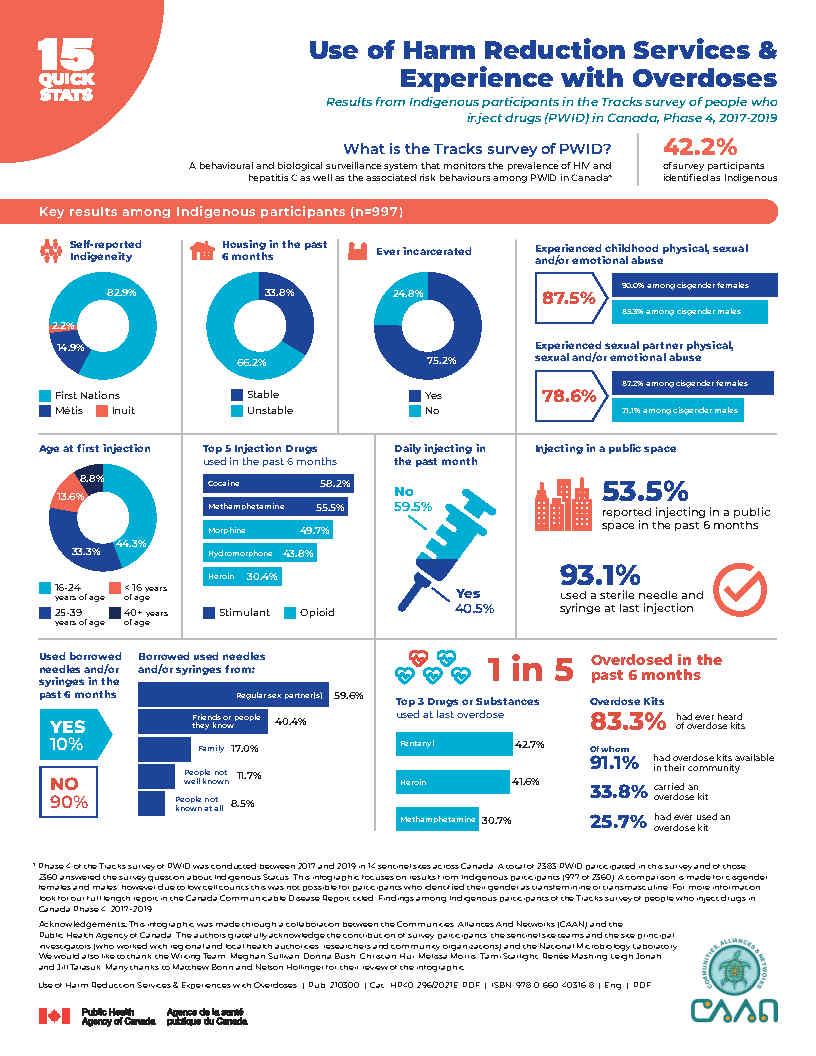Use of harm reduction services and experience with overdoses: Survey report among Indigenous participants who inject drugs in Canada, 2017-2019: Infographic
Download in PDF format
(579 KB, 1 pages)
Organization: Public Health Agency of Canada
Date published: 2021-10-14
Results from Indigenous participants in the Tracks survey of people who inject drugs (PWID) in Canada, Phase 4, 2017-2019
What is the Tracks survey of PWID?
- A behavioural and biological surveillance system that monitors the prevalence of HIV and hepatitis C as well as the associated risk behaviours among PWID in CanadaFootnote *
- 42.2% of survey participants identified as Indigenous
Key results among Indigenous participants (n=997)
Self-reported Indigeneity
- First Nations – 82.9%
- Métis – 14.9%
- Inuit – 2.2%
Housing in the past 6 months
- Stable – 33.8%
- Unstable – 66.2%
Ever incarcerated
- Yes – 75.2%
- No – 24.8%
Experienced childhood physical, sexual and/or emotional abuse
- 87.5%
- 90.0% among cisgender females
- 85.3% among cisgender males
Experienced sexual partner physical, sexual and/or emotional abuse
- 78.6%
- 87.2% among cisgender females
- 71.1% among cisgender males
Age at first injection
- < 16 years of age – 13.6%
- 16-24 years of age – 44.3%
- 25-39 years of age – 33.3%
- 40+ years of age – 8.8%
Top 5 injection drugs used in the past 6 months
- Stimulant
- Cocaine – 58.2%
- Methamphetamine – 55.5%
- Opioid
- Morphine – 49.7%
- Hydromorphone – 43.8%
- Heroin – 30.4%
Daily injecting in the past month
- No – 59.5%
- Yes – 40.5%
Injecting in a public space
- 53.5% reported injecting in a public space in the past 6 months
- 93.1% used a sterile needle and syringe at last injection
Used borrowed needles and/or syringes in the past 6 months
- Yes – 10%
- No – 90%
Borrowed used needles and/or syringes from:
- Regular sex partner(s) – 59.6%
- Friends or people they know – 40.4%
- Family – 17.0%
- People not well known – 11.7%
- People not known at all – 8.5%
1 in 5 overdosed in the past 6 months
Top 3 drugs or substances used at last overdose
- Fentanyl – 42.7%
- Heroin – 41.6%
- Methamphetamine – 30.7%
Overdose kits
-
83.3% had ever heard of overdose kits
Of whom:
- 91.1% had overdose kits available in their community
- 33.8% carried an overdose kit
- 25.7% had ever used an overdose kit
Acknowledgements
This infographic was made through a collaboration between the Communities, Alliances And Networks (CAAN) and the Public Health Agency of Canada. The authors gratefully acknowledge the contribution of survey participants, the sentinel site teams and the site principal investigators (who worked with regional and local health authorities, researchers and community organizations) and the National Microbiology Laboratory. We would also like to thank the Writing Team: Meghan Sullivan, Donna Bush, Christian Hui, Melissa Morris, Tami Starlight, Renée Mashing, Leigh Jonah, and Jill Tarasuk. Many thanks to Matthew Bonn and Nelson Hollinger for their review of the infographic.
Footnotes
- Footnote *
-
Phase 4 of the Tracks survey of PWID was conducted between 2017 and 2019 in 14 sentinel sites across Canada. A total of 2383 PWID participated in this survey and of those 2360 answered the survey question about Indigenous Status. This infographic focuses on results from Indigenous participants (977 of 2360). A comparison is made for cisgender females and males; however due to low cell counts this was not possible for participants who identified their gender as transfeminine or transmasculine. For more information, look for our full length report in the Canada Communicable Disease Report titled: Findings among Indigenous participants of the Tracks survey of people who inject drugs in Canada, Phase 4, 2017–2019.
